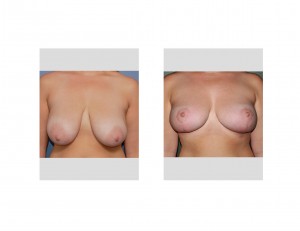Background: Sagging of the breasts is an almost expected sequelae for most women as they go through life. The effects of gravity and body changes of pregnancy and weight loss will make just about any breast mound drop. This is particularly so when one starts out with some significant breast volume making it very prone to sagging even early in life.
In correcting breast sagging, some type of breast lift is needed. There are several types of breast lifts that can be used which differ in the amount of scar created and how much the breast is lifted. The type of breast lift used can also be influenced by whether an implant is going to be simultaneously placed for volume improvement as less of a breast lift may be needed.
Breast lifts can be classified into four types, crescent nipple lifts (I), periareolar donut lift (II), vertical lollipop lift (III) and a full anchor lift. (IV) Like lifts, the amount of breast sagging is also classified into types (I – IV) based on where the position of the nipple sits relative to the inframammary fold. In theory, the type of breast lift matches the type (degree) of breast ptosis. (sagging)
Case Study: This 38 year-old female wanted to improve the shape of her sagging breasts. She had always had large breasts since she was a teenager but, after two pregnancies, they had fallen with the nipples well below the inframammary folds. She was not interested in a bigger breast size, just a better uplifted breast shape.



Case Highlights:
1) Significant sagging of the breasts requires a full breast lift which can be done without the removal of any breast volume.
2) A full Type IV breast lift creates the classic anchor scar pattern which is necessary to get a maximal breast lift and reshaping result.
3) While a full breast lift creates considerable scar lengths, half of the scare remains hidden along the inframammary crease.
Dr. Barry Eppley
Indianapolis, Indiana


